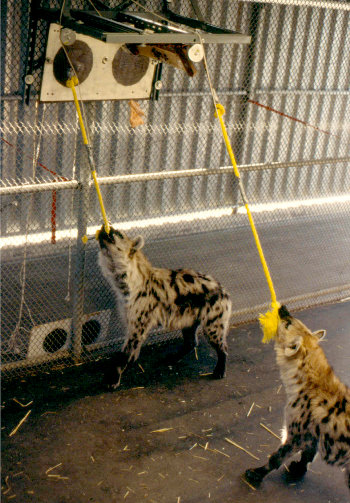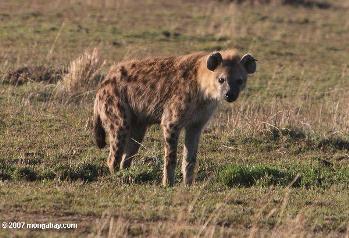Spotted hyenas (Crocuta crocuta) could show chimpanzees a thing or two about working together, according to a new study. Hyenas, prodigious hunters, pull down prey together.
Christine M. Drea, an associate professor in the department of Evolutionary Biology at Duke University, started to ask questions about the cooperative hunting habits of hyenas while she was reading The Spotted Hyena: A Study of Predation and Social Behavior by Hanz Kruuk.
“[H]e noted that these [hyena] ‘zebra hunting parties’ formed long before any zebra had been sighted, such that the hyenas had somehow communicated to one another ahead of time that they would be setting out to hunt zebra,” Dr. Drea said. “I wondered ‘how the hell do they do that?’”
 Spotted hyenas solving a cooperation task.. Photo by: Christine M. Drea. |
Similar food reward studies with apes and monkeys have yielded mixed results. Apes, such as chimpanzees, may work slowly and reluctantly, even when they are taught to cooperate. Non-human primates generally forage independently in the wild, though some species do work together for food. These species also cooperate better in laboratory settings. However, captive hyena pairs completed a cooperative task more efficiently than primates featured in comparable experimental settings, according to the study by Dr. Drea and co-author Allisa N. Carter.
“I keyed in on some of the early chimp studies,” said Dr. Drea, “and realized that the fact that hyenas readily solved a basic cooperation task was already remarkable by comparison.”
The scientists released hyena pairs into a testing enclosure containing one or two platforms elevated beyond the hyenas’ reach. Two ropes dangled from each platform. When the hyenas tugged the ropes in unison a trap door on the platform dropped food to the floor.
The actions in this study—choosing a platform, grabbing and pulling—mimicked the hunting movements natural to wild hyenas.
Dominant hyenas let their subordinate partners take the lead when partnered with a naive subordinate—a hyena new to the cooperative task. Experienced hyenas monitored and followed the actions of their naïve subordinates until they released the food. The partners resumed their original roles once the naïve hyena learned how to use the ropes.
The hyenas responded to the presence of others, working more quickly when other hyenas were in the room and less quickly when they were absent, even though they were more experienced from practicing while the other hyenas were present.
 Spotted hyena in Kenya. Photo by Rhett A. Butler. |
Efficiency also decreased when dominant hyenas were paired together. Every time one of the partners was aggressive, the other partner would move away for a time, moving away from the platform in the process.
Spotted hyenas range across Sub-Saharan Africa, excepting rainforest regions. They are one of three species of hyenas in Africa and Asia. Though often reviled for their scavenging habits, hyenas are excellent hunters with complex social systems. Dr. Drea hopes that “to the extent that [her] study sheds light on the intelligence of hyenas…it will help people better appreciate and respect them.”
“I think the important aspect has to do with the benefits of comparative research,” said Dr. Drea of her study. The findings create context for other intelligence studies and suggest that animal intelligence may depend on biological context.
Though hyenas are formidable hunters, they can also be playful. After the study finished for the day, the ropes were stored on top of the platform to prevent damage overnight. One night a highly motivated hyena managed to snag a rope and climb with his teeth until just his back toes were touching the floor. The next morning Dr. Drea “came upon him…doing a sort of wild pirouette/whirligig like a kid playing on a twisted swing. He was spinning in circles on his tippy toes.”
CITATION: Drea CM, Carter AN (2009) Cooperative problem solving in a social carnivore. Animal Behavior 78: A09-00244. doi:10.1016/j.anbehav.2009.06.030.
Related articles
Kenya moves forward to ban the pesticide Furadan after it is used to kill 76 lions

(06/08/2009) After highly-publicized poisonings of lions in Kenya’s national parks, the Kenyan Parliament has begun addressing longstanding concerns regarding the pesticide Furadan. Since 1995 Furadan has been used to illegally kill 76 lions, 15 hyenas, 24 hippos, over 250 vultures, and thousands of other birds in Kenya. These numbers are likely low due to under-reporting, according to Kenya-based conservation organization, Wildlife Direct.
Rooks use tools in captivity rivaling ‘habitual tools users such as chimpanzees’
(05/26/2009) The rook, a member of the crow family, is the most recent bird to prove the ability to use tools, a capacity once thought to belong only to humans. Although rooks have never been observed using tools in the wild, researchers were astounded at how quickly—sometimes during the first try—rooks were able to employ tools to attain food.
Male chimps use meat to seduce

(04/07/2009) Male chimpanzees who share meat with females over a long period of time have a better chance of mating, according to a new study published in PLoS ONE. Studying chimps in Tai National Park, Côte d’Ivoire, researchers from the Mac Planck Institute for Evolutionary Anthropology observed that female chimps have sex more frequently with males who have shared meat with them at least once as opposed to males who never share.